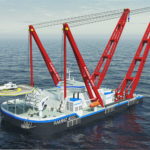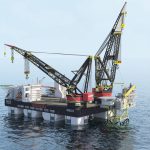In Belgium and the Netherlands some important players for offshore construction and service works are located. Two of them now plan to upgrade their fleet of special heavy lift vessels – with newbuildings from Asia
Already fixed is an order for a self-propelled DP2 crane ship by offshore marine contractor Scaldis, a subsidiary of[ds_preview] Belgiums DEME Group. The design was drawn up in-house in cooperation with Vuyk Engineering, part of Dutch company Royal IHC on the basis of the experience that Scaldis has accumulated hoisting heavy objects in challenging offshore conditions. Delivery of »Rambiz 4000« is scheduled for 2017. But the construction will not be done by a European yard. Rather the vessel is going to be built under full responsibility and coordination of Royal IHC in Qidong and finished in Xiamen.
Scaldis intends to expand its services, including the installation of offshore infrastructures and decommissioning activities for the oil and gas industry as well as the installation of offshore wind farms. »The ship can also be used for any type of marine related heavy lifting in challenging situations, such as the construction of bridge components and clearing subsea obstacles«, the company says. With a helipad in combination with accommodation for 78 people it is planned to provide a varied range of additional services.
The design of the »Rambiz« has two Huisman cranes each with a lifting capacity of 2,000t. Additionally there is an extra carrying capacity of 3,000t. The cranes can be moved by 25m on the ship. The newbuilding with a speed of 7kn has a length of 108m, a beam of 50.90m, a depth of 8m and a draught of 4.9m. According to the company, the ship and the cranes are an integrated design which allows the maximum load to be hoisted in significant wave heights of up to 1.5m. »In these circumstances, the freeboard is not less than 3m anywhere on the vessel. In standby or transport modes, significant wave height can be as much as 7m.«
The four azimuth thrusters and the DP2 system allow installation work to be conducted in deeper water without the use of anchors. »This guarantees flexibility and efficiency and also means that work can be carried out in zones where many pipelines and cables already lie on the bed, for example«. The powerful and rapid ballast system would be able to follow the hoisting operation exactly. Scaldis also has some more special works in mind, which can occur during offshore construction projects. Therefore, the »Rambiz« will be equipped with a so-called ›moonpool‹ for the purposes of operating a separate ROV (Remotely Operated Vehicle) for inspecting and supervising installation work on the seabed.
NSCV for Heerema
After several months of preparation (HANSA 10/2014), the Dutch company Heerema Marine Contractors has taken the next step for a huge newbuilding, too. The project »NSCV« would be the largest crane vessel in the world with 214m length and 97.5m width, Heerema announced. Now a Letter of Intent regarding the engineering and construction of the new semi-submersible crane vessel was signed with Singapore´s Jurong Shipyard, a fully owned subsidiary of Sembcorp Marine. According to its own statement, Heerema already owns four of the world’s largest crane vessels: »SSCV Thialf«, »DCV Balder«, »SSCV Hermod«, and »DCV Aegir« as well as the worlds largest barge »H-851«. CEO Jan-Pieter Klaver said: »Our Letter of Intent represents the next critical step in our plans to introduce the NSCV to the market. The fact that we decided to press on with our plans in these times of low oil prices, shows our belief in the offshore oil and gas industry.« The new vessel will be equipped with two cranes of 10,000t lifting capacity each. The dual cranes, designed and under construction by Huisman Equipment B.V., provide heavy lifting capacity to install and remove offshore facilities. Furthermore, they can be utilized for the installation of subsea structures, foundations, moorings, and floating structures in deep water. Station-keeping is said to be by means of dynamic positioning (DP3) or mooring system. The NSCV will be self-propelled with a transit speed of 10kn. For ecological purposes, Heerema decided to be prepared for the environmental friendly LNG as fuel. The power is generated by means of dual fuel engines – MGO and LNG.
New name for »Pieter Schelte«
Another offshore specialist company with roots in the Heerema family, Swiss-based Allseas, has decided to change the name of its huge newbuilding project »Pieter Schelte«. This had been preceded by long controversy. Pieter Schelte Heerema, the father of Allseas founder Edward Heerema was active in the Waffen-SS in World War II, before he joined the resistance in the Netherlands. Several activists and groups critizised Allseas for the naming decision. Finally Edward Heerema of Allseas announced recently, that the name will be changed to »Pioneering Spirit«. »The name reflects what the vessels stands for: a new technological step in platform installation and decommissioning. It also fits the 30-year tradition of Allseas to pioneer and surpass technical boundaries, as was done over the years introcuding pipelay on dynamic positioning and laying pipelines in ever deeper waters«, it was stated.
Michael Meyer





















